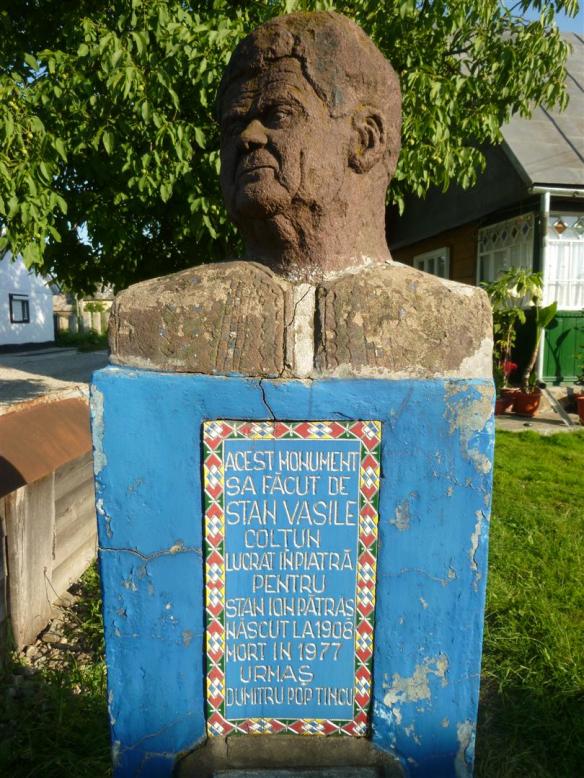 He was nine years old when he took his first lesson at the famous cemetery painter Stan Ioan Patras. He was a local carver who scrawled his first verse on a tomb around 1935 and recorded the village in poetry until his death. With him he studied for nine years. The master was looking for somebody who could continue with his art and he found that somebody in the young Dumitru. When Patras died in 1977, Dumitru overtook his work and became a famous gravestone painter. “I need about two to three months to finish a painting”, says the 57 year old artist. He doesn`t speak English but in his daughter Anamaria he has an excellent translator.
He was nine years old when he took his first lesson at the famous cemetery painter Stan Ioan Patras. He was a local carver who scrawled his first verse on a tomb around 1935 and recorded the village in poetry until his death. With him he studied for nine years. The master was looking for somebody who could continue with his art and he found that somebody in the young Dumitru. When Patras died in 1977, Dumitru overtook his work and became a famous gravestone painter. “I need about two to three months to finish a painting”, says the 57 year old artist. He doesn`t speak English but in his daughter Anamaria he has an excellent translator.
“Except cemetery painting he also creates pictures. All he wants to do is naïve art”, says his 21-year old daughter. “I love to do the geometric paintings”, he admits. Family members of persons are coming to him or even people still alive come to him and order the colourful wooden crosses. Many crosses are painted at both sides, but it depends on the money, because the more pictures are on it the more expensive is the painting.


 “Up to 500 Euro costs to illustrate one side of the cross, therefore many people can only afford one painting”, says Maia who works at the cemetery. Thus there are some crosses which only have paintings on one side.
“Up to 500 Euro costs to illustrate one side of the cross, therefore many people can only afford one painting”, says Maia who works at the cemetery. Thus there are some crosses which only have paintings on one side.
The village of Sapanta is located in a forgotten corner of Europe, near the border with Ukraine. As soon as a citizen of Sapanta dies, Dumitru gathers his note book, chisels and paint brushes and prepares a poetic and pictorial homage of the deceased onto an oak grave mark to be soon in the Merry Cemetery beside the Church of the Assumption. The about 800 carvings are a festival of colors show the dead either in life or at the moment that death caught them, while the poems, mostly written in a simple manner, are a final apology for an often ordinary life.

“Death come swiftly
Separating me from my loved ones
I left for work
And death was waiting for me
If only man would know what is to come
He would shield himself from it
My last days
I spent working
Every man on earth
Has a grave before him
But we must be prepared
For death we know not when it comes
As it came for me
And my days were over”

“Life is sweetest
One cannot bargain for it
Fate decides
I’d give all my money and effects
To give orders to my fate”

“I was a tractor driver
in the village but then
I left and went to school
and became head of department
and the village people loved me
as long as I lived
I never offended a soul
and now that I say goodbye
I wish you all the best
and do not forget me
for I left my life at
42 years of age”
Master Stan Ioan Patras was an orphan, his father died during World War I. In 1935, at age 16, in order to provide for himself and help his brothers as well, he begins making crosses at the old cemetery on the Sapanta hill. The village was mined, and in order ot enter the village the people had to send their sheep ahead. Thus, many were sacrified to save human lives.
Stan Ioan Patras witnessed this suffering, which affected him deeply, and therefore, in the early years, on each cross he drew a sheep, whether or not the person buried there had been a sheep farmer, in appreciation for their sacrifice.
 By drawing the sheep on the crosses Patras was able to “bury” them all. The cemetery was born from an obsession, from a creative spirit. Patras had become a master of death. Because the animals had been sacrified, people managed to defy death, surviving the war and its aftermath.
By drawing the sheep on the crosses Patras was able to “bury” them all. The cemetery was born from an obsession, from a creative spirit. Patras had become a master of death. Because the animals had been sacrified, people managed to defy death, surviving the war and its aftermath.






Thank you very much … It’s an amazing story! Kisses!
I did visit the place a few days ago along with my girlfriend and we met, I guess NIcoleta at the place, who told us many interesting things:) Where can I get the book, which we rather didn’t purchase on our visit?
Pingback: The Merry Cemetery, Săpânţa, Romania. | circle of life